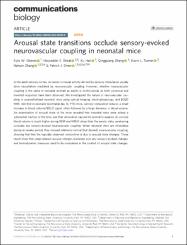| dc.contributor.author | Gheres, Kyle W. W. | |
| dc.contributor.author | Unsal, Hayreddin S. S | |
| dc.contributor.author | Han, Xu | |
| dc.contributor.author | Zhang, Qingguang | |
| dc.contributor.author | Turner, Kevin L. | |
| dc.contributor.author | Zhang, Nanyin | |
| dc.contributor.author | Drew, Patrick J. | |
| dc.date.accessioned | 2023-08-18T07:05:32Z | |
| dc.date.available | 2023-08-18T07:05:32Z | |
| dc.date.issued | 2023 | en_US |
| dc.identifier.issn | 2399-3642 | |
| dc.identifier.other | WOS:001031347400004 | |
| dc.identifier.uri | https://doi.org/10.1038/s42003-023-05121-5 | |
| dc.identifier.uri | https://hdl.handle.net/20.500.12573/1746 | |
| dc.description.abstract | In the adult sensory cortex, increases in neural activity elicited by sensory stimulation usually drive vasodilation mediated by neurovascular coupling. However, whether neurovascular coupling is the same in neonatal animals as adults is controversial, as both canonical and inverted responses have been observed. We investigated the nature of neurovascular coupling in unanesthetized neonatal mice using optical imaging, electrophysiology, and BOLD fMRI. We find in neonatal (postnatal day 15, P15) mice, sensory stimulation induces a small increase in blood volume/BOLD signal, often followed by a large decrease in blood volume. An examination of arousal state of the mice revealed that neonatal mice were asleep a substantial fraction of the time, and that stimulation caused the animal to awaken. As cortical blood volume is much higher during REM and NREM sleep than the awake state, awakening occludes any sensory-evoked neurovascular coupling. When neonatal mice are stimulated during an awake period, they showed relatively normal (but slowed) neurovascular coupling, showing that that the typically observed constriction is due to arousal state changes. These result show that sleep-related vascular changes dominate over any sensory-evoked changes, and hemodynamic measures need to be considered in the context of arousal state changes.
A combination of optical imaging, electrophysiology, and BOLD fMRI in unanesthetized neonatal mice reveals that sleep-related vascular changes dominate over sensory-evoked changes. | en_US |
| dc.description.sponsorship | United States Department of Health & Human Services
National Institutes of Health (NIH) - USA R01NS101353
Career Development Award R01NS078168
U19NS128613
American Heart Association 935961
Republic of Turkiye Ministry of National Education Scholarship | en_US |
| dc.language.iso | eng | en_US |
| dc.publisher | NATURE PORTFOLIO | en_US |
| dc.relation.isversionof | 10.1038/s42003-023-05121-5 | en_US |
| dc.rights | info:eu-repo/semantics/openAccess | en_US |
| dc.subject | CEREBRAL BLOOD-VOLUME | en_US |
| dc.subject | VOLUNTARY LOCOMOTION | en_US |
| dc.subject | HEMODYNAMIC SIGNALS | en_US |
| dc.subject | WHISKER MOVEMENTS | en_US |
| dc.subject | NEURAL ACTIVITY | en_US |
| dc.subject | SLEEP | en_US |
| dc.subject | RESPONSES | en_US |
| dc.subject | CORTEX | en_US |
| dc.subject | PLASTICITY | en_US |
| dc.subject | DYNAMICS | en_US |
| dc.title | Arousal state transitions occlude sensory-evoked neurovascular coupling in neonatal mice | en_US |
| dc.type | article | en_US |
| dc.contributor.department | AGÜ, Mühendislik Fakültesi, Elektrik - Elektronik Mühendisliği Bölümü | en_US |
| dc.contributor.authorID | 0009-0000-6906-2144 | en_US |
| dc.contributor.institutionauthor | Unsal, Hayreddin S. S | |
| dc.identifier.volume | 6 | en_US |
| dc.identifier.issue | 1 | en_US |
| dc.identifier.startpage | 1 | en_US |
| dc.identifier.endpage | 13 | en_US |
| dc.relation.journal | COMMUNICATIONS BIOLOGY | en_US |
| dc.relation.publicationcategory | Makale - Uluslararası Hakemli Dergi - Kurum Öğretim Elemanı | en_US |


















